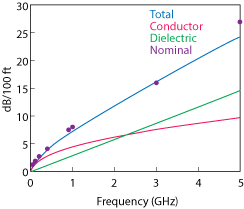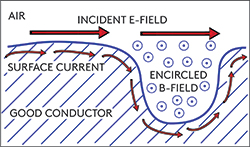mmWave Coaxial Cable and Connector Sourcing
These emerging applications will require coaxial cables and connectors in much higher volume and lower cost, without sacrificing performance, than historically provided by the industry. Shorter design cycles and competitive time-to-market will require low lead time sourcing of mmWave coaxial cables and connectors. It is likely that many current manufacturers do not stock what has previously been a niche item, and rapid availability of mmWave coaxial assemblies will be attractive to users in a much wider range of markets than before.

Figure 4 The attenuation of a coaxial transmission line increases with frequency because of the increased conductor resistance and dielectric losses. RG-8/U and RG-213/U example.4
mmWAVE CONSIDERATIONS
The reasons mmWave coaxial cables and connectors are expensive and behave differently than lower frequency coaxial systems are because of their physical, construction and material characteristics. Several frequency-dependent phenomenon drive these constraints: conductivity and skin effect, the transverse electromagnetic mode (TEM) of the coaxial transmission line, dielectric constant, propagation velocity and wavelength. The frequency-dependent conductivity of conductors and dielectric losses of coaxial transmission lines appear as a resistive loss (i.e., insertion loss) versus the frequency of the signals propagating along the line (see Figure 4).
The skin depth at mmWave frequencies is a fraction of the loss at sub-6 GHz frequencies, as the skin depth shrinks with increasing frequency. At mmWave frequencies, the distribution of electromagnetic energy traveling through a transmission line will be less than 1 µm from the surface of the conductor. For example, at 6 GHz, the skin depth for copper is 0.842 µm; at 60 GHz, the skin depth is 0.266 µm.5,6 As skin depth is a function of resistivity, magnetic permeability and frequency, materials with higher resistivity and lower magnetic permeability allow for much better transmission of mmWave signals, such as gold, silver and aluminum. These materials are more attractive to use with mmWave coaxial assemblies, leading to increased cost and more complex manufacturing and repair processes.

Figure 5 Uneven conductor surfaces leads to increased surface conductance compared to smooth surfaces.
Another effect of skin effect and TEM transmission is that surface conditions of the conductor and distribution of the dielectric within the transmission line become important factors at higher frequencies. Poorer material and surface consistency leads to greater losses and reflections/VSWR (see Figure 5). For test cables and connectors that undergo repeated reposition, flexure, vibration, shock and other forms of stress, the materials and construction methods must avoid degradation to avoid significant changes in performance.
To achieve the desired coaxial behavior, the dimensions and tolerances of the inner conductor, outer conductor and dielectric are much smaller than with lower frequency coaxial transmission lines. Smaller coaxial dimensions mean less conductor surface area and greater resistive losses and heat build-up under load. Hence, mmWave coaxial cables typically have much lower power handling and peak RF voltage, limiting usable length. Additionally, conductor and dielectric behavior depends on the temperature, humidity and other environmental factors, further limiting the materials and construction techniques viable for mmWave coaxial assemblies.
Connection repeatability for mmWave testing that involves large groups is a concern, as the tolerance of connectors are extremely tight. At mmWave frequencies, 2.92, 1.85, 1 and 0.8 mm coaxial connectors have center pins less than 1 mm in diameter. These small dimensions make these connectors susceptible to performance deviation from contaminates, oils and wear—not to mention being more fragile than larger connector sizes. Maintaining phase stability, given that small mechanical variations can dramatically change the electrical response, means that care must be taken in handling the cables and connectors. Because of these factors, field testing and troubleshooting of mmWave systems will be extremely challenging, making it difficult for technicians to use coaxial cable assemblies designed for laboratory use.
